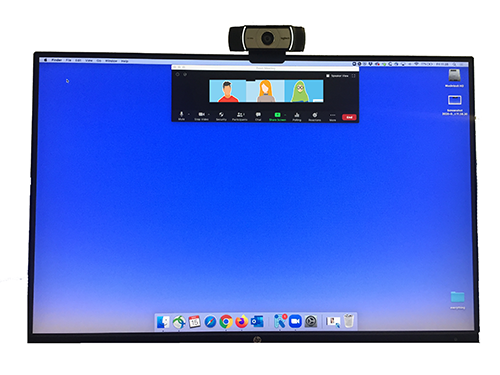Being more human online together

Many useful lists provide technical recommendations for optimising virtual meetings (here is one from the IT Services Team at ETH Zurich. In this short post, though, I will go one step further. In video conferencing we are, quite literally, “hosts”. This makes us responsible for managing the behaviour of others, especially if it is disruptive. In this context it is important to communicate our expectations clearly. This requires us to consider our own requirements and the needs and circumstances of those participating in our virtual sessions, and to find a balance between them.
Teaching involves relationships, firstly between lecturers and students, but also among students themselves. Therefore, effective facilitation addresses the needs inherent in human relationships and how we can respect these in the virtual environment.
Let’s look at some key aspects to be considered:

Eye contact
Eye contact conveys attention and interest. (Keep in mind here that some cultures prefer to avoid direct eye contact.) If you wish to transmit a sense of eye contact, you can do this by looking directly into the camera and not at the face of the person you are talking to, even if this means that you yourself lose eye-contact. One tip is to minimize the facial images and move them to the top of your screen, near your camera. Your gaze is then close to the camera, but focused on faces.
Names
Many video conferencing tools allow participants to change the name displayed alongside their image. Consider asking students to adjust this to their preferred name. “SmiJo” is a lot less personal than “John Smith” or even just “Johnny”.
Rapport
To build rapport, take the time to make people feel acknowledged and welcome at the beginning of a virtual session. Create space for “warming up” with smalltalk before launching into the reason for the session. Depending on the size of the group you may wish to greet individuals by name when they appear, even if they are late. If the group is large, you can still acknowledge latecomers en masse. Trusting that their reasons for being late are legitimate will help to create an atmosphere which is conducive to learning.
Sound
Think about how you want participants to manage sound. Is it important to minimise background noise? The more participants there are, the more distracting background noise can be. However, in smaller informal settings, ambient noise can help people feel connected – an important consideration the longer we are in physical isolation. Agree on how the mute button should be used.
Video
A common belief is that all participants should switch on their cameras when joining a Zoom meeting. However, this may be difficult for various reasons: attendees may not have a camera; there may be other people around; or their bandwidths may not be able to cope with video. Some people are also profoundly uncomfortable with displaying themselves on camera for long periods.
Lecturers should therefore consider why they want students to turn their cameras on. Then they should articulate their expectations, and consider equally acceptable alternatives. Do cameras really need to be switched on? If so, is that for the whole meeting? For example, if the meeting is long, but not particularly interactive, the lecturer might ask the students to turn their cameras on at the beginning to “establish contact”, but say that it’s OK to switch them off later. This might be especially relevant if everyone is viewing slides, for example. Using “hide self view” can also minimise the cognitive fatigue we are all experiencing due to the increased frequency of online meetings and length of time spend in video conferences.
Remember that not everyone thinks about how they appear on screen: it may be useful to give people feedback and guidance in this area. Their lighting may make their images too dark to see, or if the video is flickering it can be hard on the eye after a time.
Background
The background displayed on the screen can be both informative and distracting. Students may choose virtual backgrounds to obscure a messy room or one that reveals things they prefer to keep private (such as family photos or an extensive wine collection). If their choice of background is too distracting you should let them know. Conversely, you can use the virtual background function as a way to connect. Ask people to share a photo of a place meaningful to them, or an image that provides comic relief!
Movement
As the host, when you view a gallery of many faces your eye will naturally be drawn to movement. If people join via mobile phone or tablet, they are likely to be more mobile and may move around in their spaces. This is sometimes unavoidable, but it can be very distracting. Make participants aware of this and ask them to deactivate their screens if they change positions or if they are moving around a lot.
Chat
Think about the best way to use the chat function. Will you be monitoring it actively, or not at all? Would you like people to use the chat to announce their departure from the session? Most video conferencing tools offer multiple ways to communicate. Tell your students how you want them to use them.
The intention of this post was to encourage you to think broadly about how you run a virtual meeting or lecture as well as how you manage your own on-screen behaviour. Our available technology provides us with so many options, but these sometimes generate divergent behaviour. Here establishing fair expectations will go a long way towards facilitating a successful virtual event.
Posted on
in Activities

